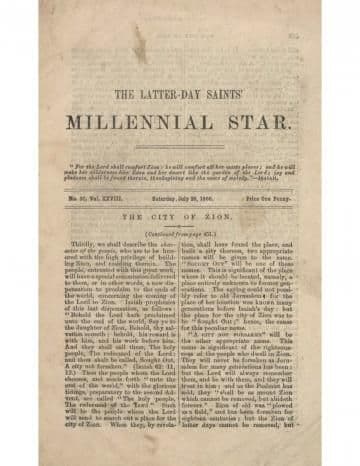Magazine
Books of the Bible

Title
Books of the Bible
Magazine
The Latter Day Saints' Millennial Star
Publication Type
Magazine Article
Year of Publication
1866
Editors
Young, Brigham, Jr. (Secondary)
Pagination
467–468
Date Published
28 July 1866
Volume
28
Issue Number
30
Abstract
This article discusses the development of different versions and translations of the Bible.
BOOKS OF THE BIBLE.
When and by whom were the books of the Old Testament first collected and arranged?
By Ezra, about 450 years before Christ. The five books of Moses had been kept with the Ark of the Covenant (Deut. 31:24, 26) and Joshua had written the portion of Scripture bearing his name, “in the book of the law of God.” Joshua 8 and 24:26.
What are the most prominent translations of the Bible that have been made?
The Septuagint, the Vulgate, the Douay, and the English or King James’ Bible.
What is the meaning of the word Septuagint?
Seventy. The translation was so called because it was made by seventy, or more strictly, by seventy-two men; six having been chosen from each of the twelve tribes of Israel for that purpose.
When and where was this translation made?
At Alexandria, in Egypt, about 200 years before Christ. It was a translation of the Old Testament only, from the Hebrew into Greek.
How was this translation regarded by the Jews in the time of Christ?
It was regarded with peculiar reverence. Our Savior and the Apostles, in their discourses, generally quoted from this version.
What is the Vulgate translation?
It is a Latin translation of the Septuagint, not of the Hebrew, and so called the Vulgate, because, being the only version which the Roman Catholic Church holds to be reliable, it is in that church the common version.
When and by whom was this translation made?
By Jerome, about the year A.D. 400.
What of the Douay Bible?
It is an English translation of the Vulgate, with the notes and comments, and is the only English Bible approved by the Roman Catholic Church.
From what did it receive its name?
From the place where it was first published—Douay, a town in France.
When was it published?
In the year 1610.
Why does it differ so much from our English Bible?
Because it was made, not from the original Hebrew, but from the Vulgate, which was from the Septuagint, and was very imperfect. It could not be as correct as a translation made directly from the Hebrew.
Why is our English version called “King James’ Bible?”
Because it was made during the reign of James I. King of England.
When was it began and when completed?
In the year 1607 the work was commenced, and was finished in about three years, and published in 1611.
By whom was the translation made?
Fifty-four of the most learned men of the kingdom were appointed for the task. Seven of these did not serve, leaving forty-seven as the number who were actually engaged in the work.
How was the labor apportioned among this number?
They were divided into six classes; to each of which a certain portion of the Bible was given to translate, not from the Latin nor from the Septuagint, but directly from the original Hebrew and Greek.
What was the earliest division of the Bible?
That which is supposed to have been made by Ezra. The books of the Old Testament were divided into three classes: “the Law,” “the Prophets,” and “the Writings,” or“ the Psalms.” To this our Savior refers, Luke 22:44—“All things must be fulfilled, which were written in the Law of Moses, and the Prophets, and Psalms concerning me.”
When and by whom was the Bible first divided into chapters?
This is generally said to have been done by Cardinal Hugo, A.D. 1240. But as early as the middle of the third century, the four Gospels had been divided into chapters.
When and by whom were the chapters divided into verses?
By Robert Stevens, in the year 1551. It is stated that he performed the greater part of this tedious task while on horseback, on a journey.
Subject Keywords
Bibliographic Citation
Terms of use
Items in the BMC Archive are made publicly available for non-commercial, private use. Inclusion within the BMC Archive does not imply endorsement. Items do not represent the official views of The Church of Jesus Christ of Latter-day Saints or of Book of Mormon Central.